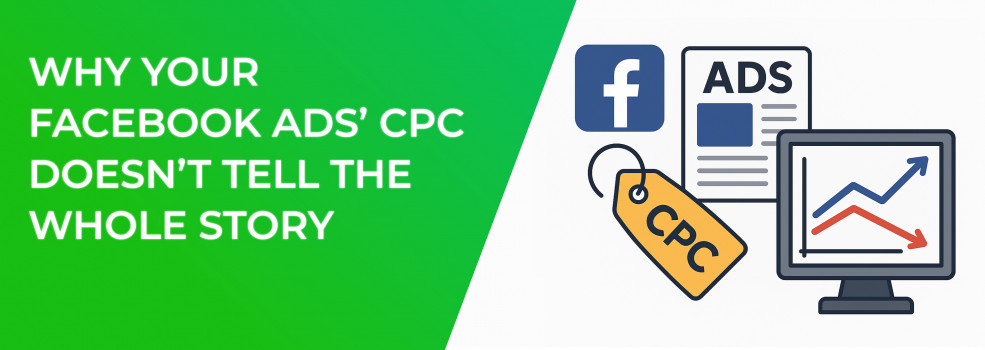When advertisers chat about Facebook ad performance the conversation quickly zooms in on cost per click (CPC). Celebrating a drop in the average CPC on Facebook feels like winning the lottery, and it is tempting to treat that single number as the scoreboard for your entire campaign.
Here is the catch: CPC is only a single lens. A great novel is measured by its character arcs, pacing, and payoff, not by its page count. The same principle applies to your ads. Below you will see how CPC can mislead, which additional metrics complete the narrative, and the Facebook ad optimization moves that turn traffic into revenue.
Before diving into the numbers, keep two guiding questions in mind:
-
“What business result am I chasing?”
-
“Which metric directly proves I am getting closer?”
Answer those, and CPC slips neatly into the supporting-actor role it deserves.
For a fuller checklist of numbers that matter, explore How to Analyze Facebook Ad Performance Beyond CTR and CPC.
The Limits of CPC
Many advertisers discover the hard way that a bargain click can mask expensive problems. Consider the following pitfalls.
-
Clicks are not conversions
Driving a flood of $0.30 clicks is irrelevant if they never purchase. Low CPC with weak intent inflates your cost per acquisition (CPA) later. -
CPC ignores context
The average cost per click Facebook marketers quote in e-commerce is meaningless to a niche B2B SaaS brand. Benchmarks vary by industry, season, and placement. -
Bid strategy distorts CPC
Features such as campaign budget optimization and the newer Advantage Campaign Budget often chase the lowest auction price. That can slash CPC while also shifting spend toward audiences that rarely convert. -
Platform changes keep moving the goalposts
Meta tweaks its auction every month. What felt like a good CTR on Facebook ads in 2023 may be mediocre today. CPC alone cannot reveal whether you are genuinely improving.
If cheap clicks aren’t turning into sales, this guide on Facebook Ads Not Converting: How to Fix It walks you through the fastest fixes.
Metrics That Complete the Picture
You have likely heard the saying “what gets measured gets managed.” The trick is to measure a portfolio, not a single stat. The table below summarizes the numbers most pros track. Read the explanation first, then use the benchmarks as a rough compass, not a rigid scorecard.
To set the scene: imagine you just launched a new campaign. You see a promising CPC, but sales are flat. The next logical move is to scan these metrics and pinpoint where the funnel leaks.
* Benchmarks differ by industry and season. Track against your own history first.
Take a breath before scrolling on. Ask yourself whether your current dashboard makes these numbers obvious. If not, tweak your reporting so you can spot problems at a glance. Once that foundation exists, you can act with confidence.
How to Tie CPC to Real-World Results
The moment your metrics are visible, optimization begins. Below are proven tactics that savvy media buyers follow week after week. Think of them as a checklist, not a one-time trick.
Set up robust tracking
Install or create Pixel on Facebook and map events across the full funnel: View Content → Add to Cart → Initiate Checkout → Purchase. Without that data your optimization tools fly blind.
Accelerating that data flow also speeds up learning—here’s how to Finish the Facebook Learning Phase Quickly.
Segment by objective
Run distinct ad sets for traffic, leads, and direct sales. Conversion-optimized campaigns rarely win the lowest CPC, but they often dominate in ROAS.
Leverage audience signals instead of hunches
Look-alike audiences, layered interests, and broad targeting tested through Advantage Campaign Budget help you scale without siphoning spend into low-intent clicks.
For a side-by-side comparison of the options, read Custom vs Lookalike Audiences: What Works Best for Facebook Campaigns?.
Iterate creative before fatigue sets in
A high CTR today can crumble fast. Swap images, headlines, and formats every seven to ten days. Keywords such as Facebook ad photo size matter less than fresh angles that grab the feed.
Watch blended metrics, not vanity wins
Celebrate a cheaper click only if CTR, CPA, and ROAS stay on track. That wider lens keeps you from chasing hollow victories.
A brief reminder: optimization is never finished. Meta’s auction evolves, competition shifts, and audiences change. Keep testing and keep questioning yesterday’s assumptions.
Case Snapshot: The Cheaper-Click Trap
Picture a medium-sized e-commerce brand. Management applauded when the media buyer dropped CPC from $1.90 to $0.72 in a single quarter. Celebration was short-lived:
-
CTR fell from 1.8% to 0.8%.
-
CPA climbed from $38 to $67.
-
ROAS sank below break-even.
Cheaper clicks often bring cheaper results — this brand learned the hard way.
The team reversed course. They re-enabled campaign budget optimization, narrowed audiences to proven look-alikes, and refreshed creative. CPC crept up to $1.65 but:
-
CTR rebounded to 1.6%.
-
CPA settled at $35.
-
ROAS climbed to 3.4×.
Lesson learned: a headline-grabbing CPC can distract from the metrics that actually deposit money in your bank account.
Bringing It All Together
When you open Ads Manager tomorrow, let CPC inform — never dictate — your next move. Pair it with CTR, CPM, CPA, ROAS, and frequency. Use Facebook ads advice rooted in data, not gut feel, and lean on automation features like Advantage Campaign Budget only after your Pixel signals are trustworthy.
Once you have profitable foundations, follow The Science of Scaling Facebook Ads Without Killing Performance to grow without losing efficiency.
Clicks are the opening act. Conversions are the encore. Judge your performance accordingly and you will tell the whole story, not just the chapter titled “cheap traffic.”

